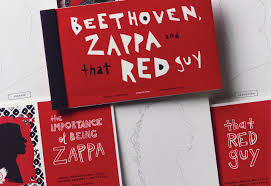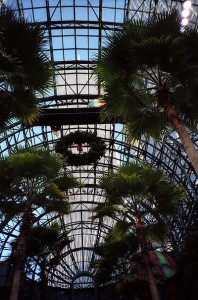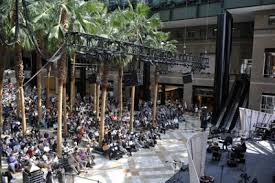[contextly_auto_sidebar id=”MSUNXhB7U7DH8Yr3nDGELAyL5CxYy2NJ”]
Continuing, about groups that successfully attracted a new, young audience…
In my first post on this, I told two success stories. About the Orchestra of the Age of Enlightenment, in London, which rebranded itself in the style of current culture, and now reliably attracts young audiences of up to 1000 people.
And about Wordless Music, in its early years in New York, which combined classical music with indie rock, or in one case with a big indie rock name, Jonny Greenwood, the guitarist in Radiohead. And reliably drew large young audiences, who loved the classical music they heard. Especially to an orchestra concert featuring Jonny Greenwood, even though his music was a contemporary classical piece with not a trace of rock in it.
See the post for links.
More, more, more
And others have done this. Here’s a list, though with less detail than before.
New music ensemble in Milwaukee. For years they’ve been drawing hundreds of people to their concerts. And they have quite a few subscribers. One way they do this is with lively (though quite serious) programming. They have fun!
And they’ve staged concerts that segue at the end into a party.
And, according to a page that’s not on their website anymore, they’ve had an audience development committee with no fewer than 15 people on it.
One lesson that committee seems to teach: If you want a new audience, you have to be serious about it. You have to put work into it, make it a top priority.
Quote (about their upcoming Thanksgiving concert):
Gather together as handbells, instruments, drums and voices start the holiday season. Present Music‘s vocal ensemble, Hearing Voices, will perform alongside over 90 instrumentalists and vocalists from the Milwaukee Handbell Ensemble, the Bucks Native American Singing and Drumming Group, the Milwaukee Youth Symphony Orchestra, Vocal Arts Academy, and Muskego High School. Celebrate creation with [Kamran] Ince’s Hammers and Whistlers (commissioned by PM in 2006) and Gloria Everywhere, and [Gavin] Bryars’ Jesus Blood Never Failed Me Yet, with jubilant sounds from the brass and choirs!
And see some testimonials here.
 Gave concerts in Cleveland from 2001 to 2008, when it died because of bad financial problems. I had a lot of communication with the people who ran it, at one point, when I was arranging their participation on a panel I was chairing. They told me they drew 1000 younger people to their events.
Gave concerts in Cleveland from 2001 to 2008, when it died because of bad financial problems. I had a lot of communication with the people who ran it, at one point, when I was arranging their participation on a panel I was chairing. They told me they drew 1000 younger people to their events.
How? Exciting programs. Collaborations (according to the otherwise sketchy Wikipedia entry I linked above) with film, puppets, visual art, and more. One program I remember linked a Haydn symphony with Eight Songs for a Mad King, a Peter Maxwell Davies theater piece about the madness of George III, who reigned in England while Haydn was in his prime.
And also branding — with, guess what, the color red. People coming to the concerts often dressed in red. Which, to state the obvious, shows the group getting traction with its audience.
 Held in recent years in the Winter Garden of the World Financial Center in New York, a lofty indoor space, and I do mean lofty, It’s 120 feet high, glass-enclosed, big enough to comfortably hold some very tall palm trees.
Held in recent years in the Winter Garden of the World Financial Center in New York, a lofty indoor space, and I do mean lofty, It’s 120 feet high, glass-enclosed, big enough to comfortably hold some very tall palm trees.
It’s on the Hudson River, along a path where people walk and bike. And in the building all around it are shops and restaurants. On spring weekends, when the all-day Marathons happen, people by the hundreds pass by outside, and pass through the space.
Many stop to listen, sitting either in folding chairs set up many rows deep in front of the stage, or else on the expansive curving staircase that goes from the lower to upper levels of the space.
And what’s remarkable is that some people seem to stay for hours. Some years ago the concerts ran all night. I was there at 3 AM. I counted 600 people, all listening to a rigorous, challenging percussion piece. And then mobbing the tables where CDs were sold.
 In the first year the Marathon happened in this space, Bang on a Can estimated 1000 people at a time where there. I asked David Lang, one of the Bang on a Can composer/founder/leaders, who these people were. “We don’t know,” he said. Best possible answer! They were getting a new audience.
In the first year the Marathon happened in this space, Bang on a Can estimated 1000 people at a time where there. I asked David Lang, one of the Bang on a Can composer/founder/leaders, who these people were. “We don’t know,” he said. Best possible answer! They were getting a new audience.
The next year it looked like the crowd was twice as large.
A lesson here: I keep saying that we in classical music have to leave our protected little park, and go out into the wider culture. Bang on a Can did that simply by finding a space that people in the wider culture already loved. Which then let these people make their own connection with the music. It turned out to be stronger than many of us might have guessed.
More coming. Still more groups have found the audience so many of us talk about. There’s been such success, in fact, that I think we can start to say we know how to do it. Or, anyway, that there’s one general approach — going out into the wider culture and making connections — that seems to work. Which then might mean that many of the hopeful discussions we have about ways in which it might be done — well, just maybe, these discussions are now at least a little out of date.

I’m afraid that one lesson I learn from most of these stories is don’t be a great big symphony orchestra.
Well, the big orchestras could do these things if they wanted to. I went to the first Wordless Music indie rock/classical concert with someone high on the staff at a big orchestra, and his immediate response was, “We should be doing this.” No reason they couldn’t
I used to tease people in the Cleveland Orchestra management, telling them they should acquire Red. But in fact I was serious. I also told people at Red that they should acquire the Cleveland Orchestra! Which would have shaken things up, but of course could never happen.
But, quite seriously, there’s not one of the things I’m reporting in this series of posts that a big orchestra couldn’t do. And there may be some big orchestras here or abroad that in fact have done them. Don’t know whether you count New World Symphony on a list of big orchestras, though they certainly have a big orchestra-sized staff. They’re doing some great things, as I’ll report. And in fact are collaborating with other orchestras, including Detroit and Pittsburgh, so that maybe big orchestras will really start doing what New World has done.
I think big orchestras (1) are risk-averse (2) have maxed-out budgets, no matter how large the budgets are, and (3) have maxed-out their staff time and energy. So it’s hard for them to try something brand new. But they could do it if they wanted to.
big orchestras (1) are risk-averse (2) have maxed-out budgets, no matter how large the budgets are, and (3) have maxed-out their staff time and energy.
This.
They could do it if they really wanted to, sure – emphasis on really. As with any large organization or system involving human beings, big change doesn’t happen until not changing becomes more painful – more immediately painful – than changing would be.
Oh, and yes – the Cleveland Orchestra perhaps could and should have acquired RED (especially after its sudden and inglorious collapse). And Apollo’s Fire, too.
But that would, in short order, make those smaller ensembles more risk-averse (and thus less interesting), because any large organization becomes risk-averse because there’s so much more (money, people’s jobs, etc.) at risk.
I did forget one example. The NY Philharmonic a couple of years ago did concert performances of Le grand macabre, Ligeti’s opera, which had never been performed in New York. These performances were on a subscription series. Subscribers turned in their tickets, and the Philharmonic resold them to younger people. I was there for the first performance. Full house, screaming younger crowd. Great event! It _can_ be done.
Oh, I was there; I remember it well. (Who could forget Eric Owens as the emperor Death himself, swathed in sumptuous fabric, striding grandly down the Avery Fisher Hall aisle looking like nothing so much as the great Jessye Norman herself?)
It does seem like a dandy trick to put a concert like that on regular subscriptions, let the subscribers turn in their tickets and then re-sell them, but I think an orchestra can only do it so many times before those subscribers catch on and rebel.
Good point there. So in the end orchestras (and other classical music institutions) have to create a separate brand for their new audience (which may not be all that young — many people in their ’50s are just as far form classical music as people in their 20s and 30s).
This can be done. More examples I just thought of: Mason Bates and Anna Clyne doing a new music series for the Chicago Symphony. Huge young crowds, from what I’ve heard. And then the new music concerts John Adams did for the San Francisco Symphony decades ago. I went to one. BIG young crowd. It’s just a matter of priority, focus, and branding. If you really want to do this, it can be done.
Not to forget the L.A. Phil’s Green Umbrella Concerts.
I’d want to hear more about groups like Red which no longer exist (and which we could technically consider a failed attempt at what you’re proposing). We could learn far more from the many failed attempts than the few survivors. That’s what the Survivorship Bias is about after all.
As Jason Cohen said (paraphrasing Peter Norvig): “[W]hat if twenty other coffee shops had the same ideas, same product, and same dedication as Starbucks, but failed?” In other words, I’d like to know about the twenty groups (for every one you’ve discussed) that haven’t succeeded in the ways you’re imagining, so we know how these strategies actually work.
Dave McRaney states that
Which certainly works both ways for those proclaiming the successes of orchestras who haven’t declared bankruptcies or gone through contentious labor negotiations as well as the organizations that are doing many of these things advocated here and succeeding. We lose a lot of useful information that way because how do we know that doing what these groups have done works when we don’t know how many groups have also done the things these groups have done (such as Red) and haven’t managed to make it work?